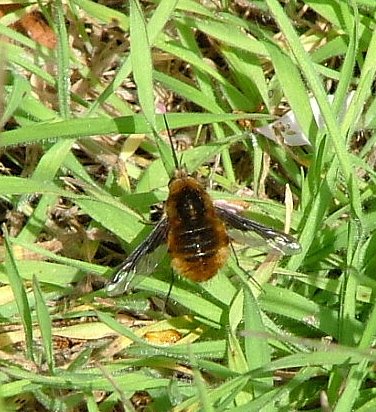
Photo ©2007
J. Lance, BCP
Click photo for a larger image
Bee Fly - Bombylius major
Family - Bombyliidae
Also known as - Greater Bee Fly

Photo ©2007
J. Lance, BCP
Click photo for a larger image
The common name "Bee–fly" reflects the size 12–17mm (0.5–0.7in long) and all over fury body of this fly that superficially resembles a bumblebee. There are ten different species of Bee–fly in Britain, the Bombylius major shown here is the most common and regularly found in Brickfields Park. It is easily identified by its long, rigid proboscis, the hovering over plants and the darting, high–pitch whining flight. They do not bite or sting and prefer sunny patches on the edges of woodland, roadsides, fields and gardens. They can be observed between March and June.
With some exceptions, Bee–flies are parasites of solitary bees and wasps. The female lays her eggs near the nests of host insects or on flowers that are visited by the host insects for their nectar and pollen. The developing larvae make their own way into the host nest or attach themselves to bees or wasps who visit the flowers to be carried into the nest by the host species. Once there, the larvae feed on the food store and the young bees or wasps.
Picture and Bee Fly information courtesy and copyright 2007/8 J. Lance.
Site design ©1999– Brickfields Country Park - Privacy -